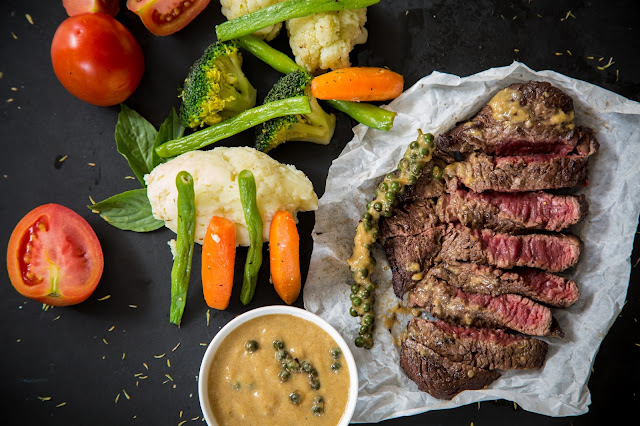Steak Recipe - How To Make Steak Tender You invest a lot of time and money into the steaks for a special occasion and when dinner time comes, they are tough. What happened? How can you cook steaks as tender as your favorite restaurant? The first step to cooking a good steak is to choose the right grade of steak. The top quality beef is graded USDA Prime and commands top prices. USDA Prime grade meats are sold to the restaurant industry and specialty markets and are not as likely to be found at your local grocery chain. The next grade of beef is USDA Choice. USDA Choice is tender, flavorful and only slightly lower in quality than USDA Prime. The meat is well marbled with fat and will be tender and juicy when properly prepared. USDA Choice makes up about 70% of all graded beef and is readily available in your supermarket. USDA Good graded beef is an acceptable grade of beef that has only minimal marbling of fat. It is leaner, but may not be as tender as USDA Prime or Choice. Next, ...
Steak Recipe - How To Make Steak Tender
You invest a lot of time and money into the steaks for a special occasion and when dinner time comes, they are tough. What happened? How can you cook steaks as tender as your favorite restaurant?
The first step to cooking a good steak is to choose the right grade of steak. The top quality beef is graded USDA Prime and commands top prices. USDA Prime grade meats are sold to the restaurant industry and specialty markets and are not as likely to be found at your local grocery chain. The next grade of beef is USDA Choice. USDA Choice is tender, flavorful and only slightly lower in quality than USDA Prime. The meat is well marbled with fat and will be tender and juicy when properly prepared. USDA Choice makes up about 70% of all graded beef and is readily available in your supermarket. USDA Good graded beef is an acceptable grade of beef that has only minimal marbling of fat. It is leaner, but may not be as tender as USDA Prime or Choice.
Next, look at the color and texture of the meat. A good steak should be firm to the touch, moist, and bright in color. It should be well marbled with thin streaks of white fat throughout and a thin crust of steak on the outside. In our fat conscious society, we tend to look for lean cuts of meat, but the thin streaks of white fat marbled throughout the meat are the key to a tender juicy steak.
The most tender and juicy steaks come from the sirloin, the short loin, and the rib. These steaks include the sirloin steaks, porterhouse steaks, t-bone steaks, rib steaks, delmonico steaks, and the filet mignons. Steaks containing bone will weigh more than those without, but the bone adds flavor to the steak.
Aging is a desirable process that intensifies the flavors and makes the meat more tender. Aged steaks are more expensive and usually only found in high end supermarkets and specialty markets. An aged steak is recognizable by its darker color.
Once you have purchased your steak, you can further increase the tenderness and juiciness by marinating it. Try a marinade made of cup each good wine and olive oil mixed 2 Tablespoons of lemon juice or herb vinegar. Add any seasonings that you like such as garlic, freshly ground pepper, onion, or herbs. Place the steak in a ziplock bag, pour in enough marinade to just cover it, and refrigerate overnight. Marinating a steak like this will add flavor and tenderness. If you routinely store steak in the freezer before cooking, try pouring the marinade over the steak before freezing. The steak will marinate when thawing and be ready to cook.
There are meat tenderizers available to sprinkle onto your steak, and they certainly do tenderize the meat; however, meat tenderizers can sometimes over tenderize the meat, changing the texture of the meat into mush. If you should choose to go this route, do it carefully.
When ready to cook, slash through the outside fat layer on the steak in a few places to prevent curling, but do not cut into the meat. The more tender steak cuts can be broiled, grilled, or pan fried. Less tender cuts should be pan fried or slow braised. Steak should never be cooked in liquid. When pan broiling, use a very heavy skillet such as an iron skillet or griddle and heat the pan before adding the meat. The heavy metal will hold the heat for proper heat distribution and not cool down when the steak is added. A hot pan will quickly sear the outside, trapping the moisture inside.
When cooking, try to turn the steak only once. Cook the meat until browned on one side and half done, then turn and finish the other side. Turning too often will stew the meat rather than searing it and produce a less juicy steak. When the steak is done, remove from the pan and allow to rest for a few minutes before serving.
While the meat rests you can make a sauce with the pan drippings if desired. Use your favorite sauce, or fry mushrooms and onions in the pan. When nearly done, add a tablespoon each of butter and flour and cook until lightly browned. Add a splash of wine and loosen any bits that may be stuck to the bottom of the pan. Allow to cook until thick, taste and adjust seasonings, and serve over the steak. Enjoy!

Comments
Post a Comment